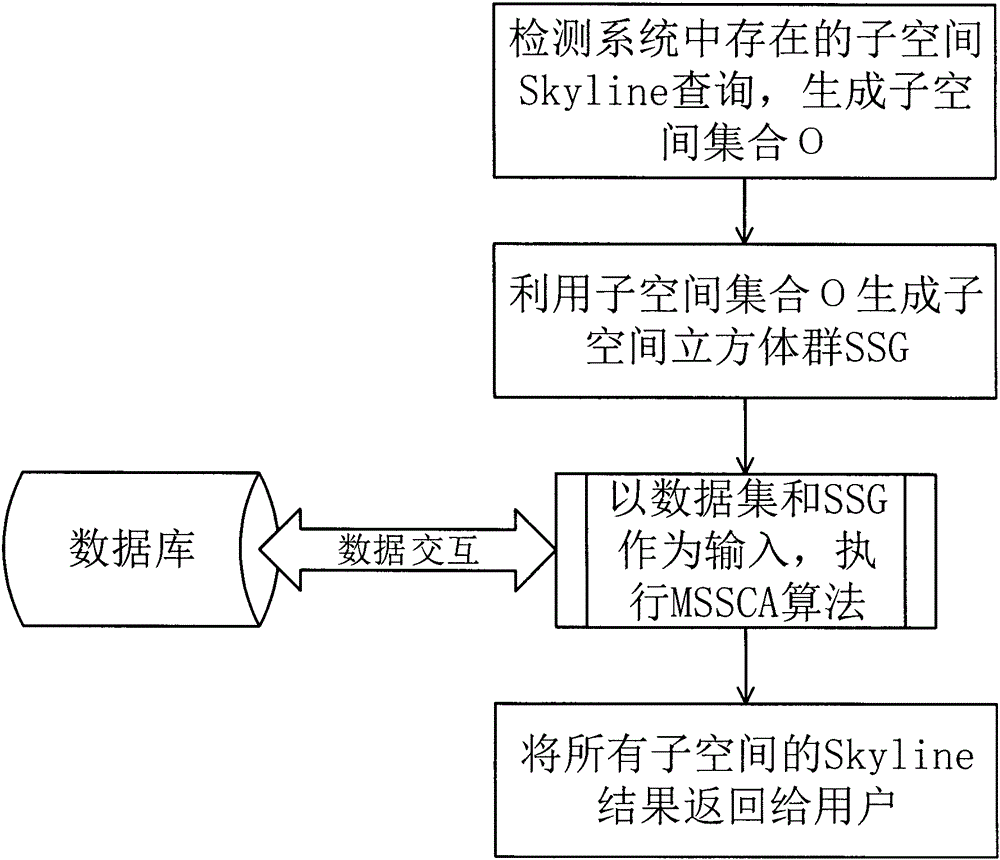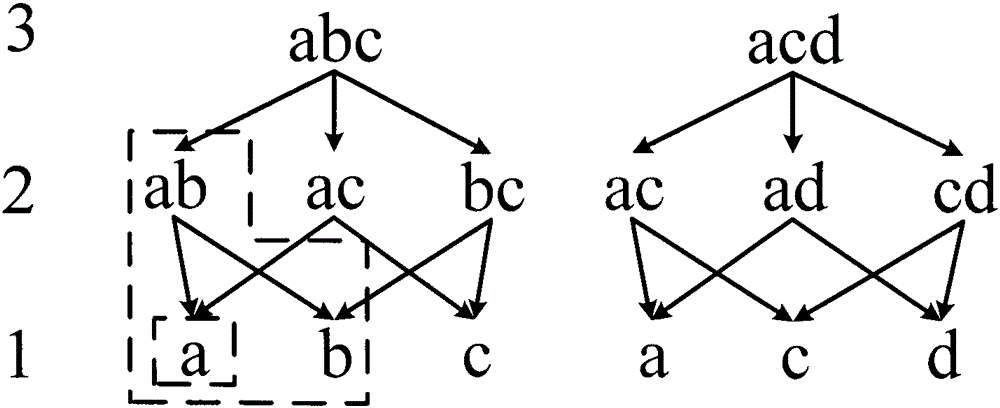Multi-subspace Skyline query computation method
A computing method and subspace technology, applied in computing, special data processing applications, instruments, etc., can solve problems such as low efficiency, achieve the effect of improving efficiency and reducing the number of data comparisons
- Summary
- Abstract
- Description
- Claims
- Application Information
AI Technical Summary
Problems solved by technology
Method used
Image
Examples
Embodiment 1
[0036] Embodiment 1 of the present invention has introduced the method for generating subspace cube group (SSG) by a plurality of subspaces, and this structure has guaranteed the effective execution of follow-up algorithm, and specific step process is as follows figure 2 shown, including:
[0037] (1) First detect all subspaces in the database system to form a set of subspaces O={V 1 ,...,V n}, where the number of subspaces included is assumed to be n;
[0038] (2) Initialize the subspace cube group set SSG as an empty set, and then process all subspaces in the subspace set O one by one;
[0039] (3) If all subspaces have been processed, return the current SSG to end the process, otherwise continue;
[0040] (4) If the currently processed subspace V i If it belongs to SSG, then process the next one, otherwise continue;
[0041] (5) put V i The place is constructed as a subspace cube SSC and added to the SSG;
[0042] (6) Return the SSG obtained from the above calculati...
Embodiment 2
[0045] Embodiment two of the present invention is as Figure 4 As shown, the generation method of the subspace candidate set (SSKY) is introduced. SSKY avoids the determination of the dominance relationship of the data points that must be the result of the subspace Skyline, and improves the efficiency. The specific implementation process includes:
[0046] (1) First, for the subspace V being calculated, find all child subspaces of V according to its corresponding subspace cube SSC;
[0047] (2) Find the union of the Skyline result sets of all child subspaces of V, and assign it to SSKY;
[0048] (3) For the Skyline results of each child subspace of V, find out the data points that are not the Skyline results on V, and assign them to TEMP;
[0049] (4) Remove the TEMP of all child subspace Skyline result sets of V from SSKY;
[0050] (5) Finally, the obtained SSKY is the candidate set of subspace V.
Embodiment 3
[0052] Embodiment three of the present invention is as Figure 5 As shown, the specific execution flow of the MSSCA algorithm in the present invention is described. Based on the foregoing description, this embodiment shows a multi-subspace Skyline query algorithm based on subspace cube groups combined with multiple optimization methods——MSSCA algorithm. include:
[0053] Algorithm at first utilizes the subspace cube generation method in the first embodiment, a plurality of subspaces existing in the system are preprocessed, subspace collection O={V 1 ,...,V v} into a subspace cube group; next, the data set is preprocessed, and the data set is sorted on all the dimensions contained in the first layer of the subspace cube group, thereby forming several data sequences; after that, due to the first layer All subspaces are 1-dimensional, so the Skyline results of the first layer of subspaces can be directly obtained according to the corresponding ordered data sequence; after that,...
PUM
 Login to View More
Login to View More Abstract
Description
Claims
Application Information
 Login to View More
Login to View More - R&D
- Intellectual Property
- Life Sciences
- Materials
- Tech Scout
- Unparalleled Data Quality
- Higher Quality Content
- 60% Fewer Hallucinations
Browse by: Latest US Patents, China's latest patents, Technical Efficacy Thesaurus, Application Domain, Technology Topic, Popular Technical Reports.
© 2025 PatSnap. All rights reserved.Legal|Privacy policy|Modern Slavery Act Transparency Statement|Sitemap|About US| Contact US: help@patsnap.com



